外研版必修3 Module 6 Old and New Grammar课件(49张ppt)
文档属性
| 名称 | 外研版必修3 Module 6 Old and New Grammar课件(49张ppt) | 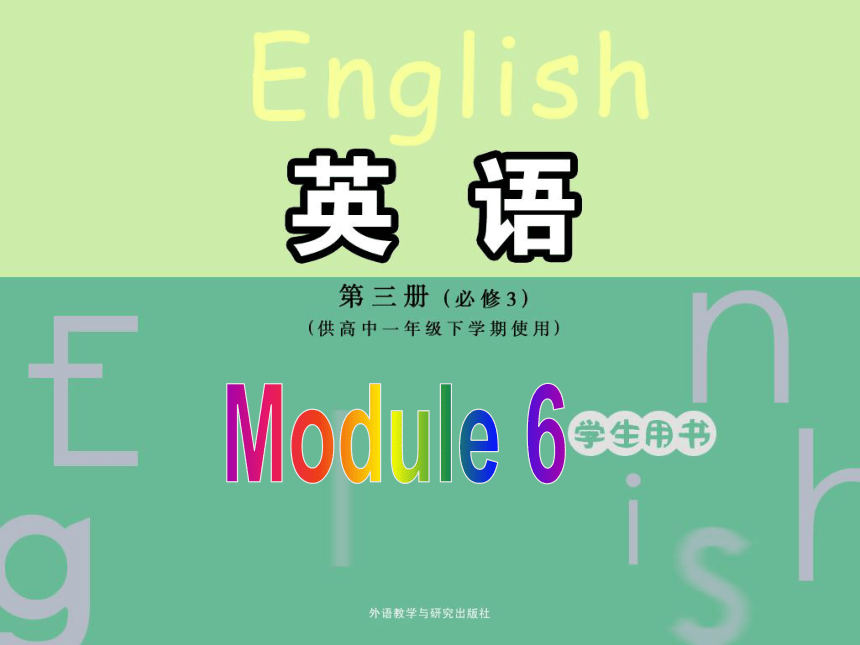 | |
| 格式 | zip | ||
| 文件大小 | 2.0MB | ||
| 资源类型 | 教案 | ||
| 版本资源 | 外研版 | ||
| 科目 | 英语 | ||
| 更新时间 | 2022-01-28 13:18:24 | ||
图片预览

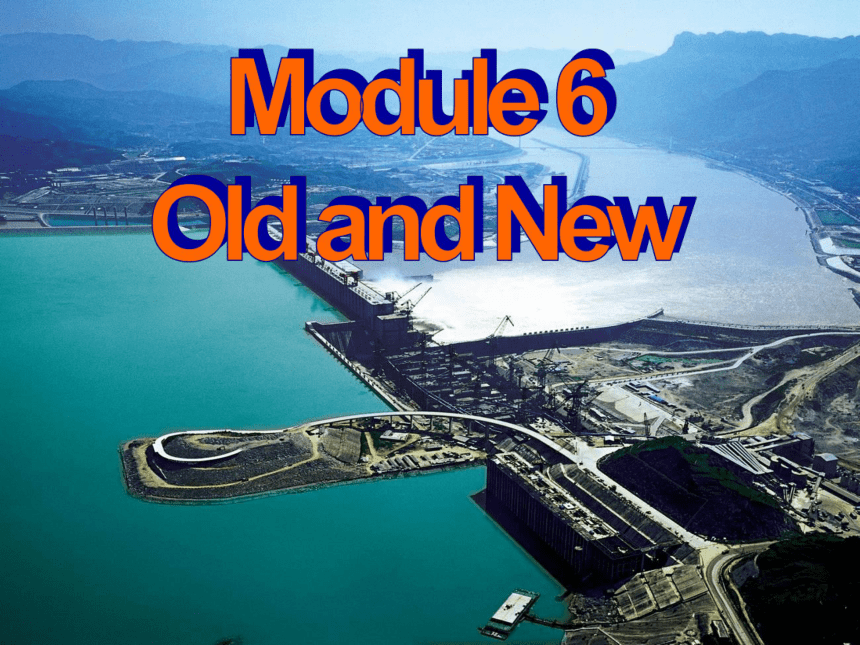
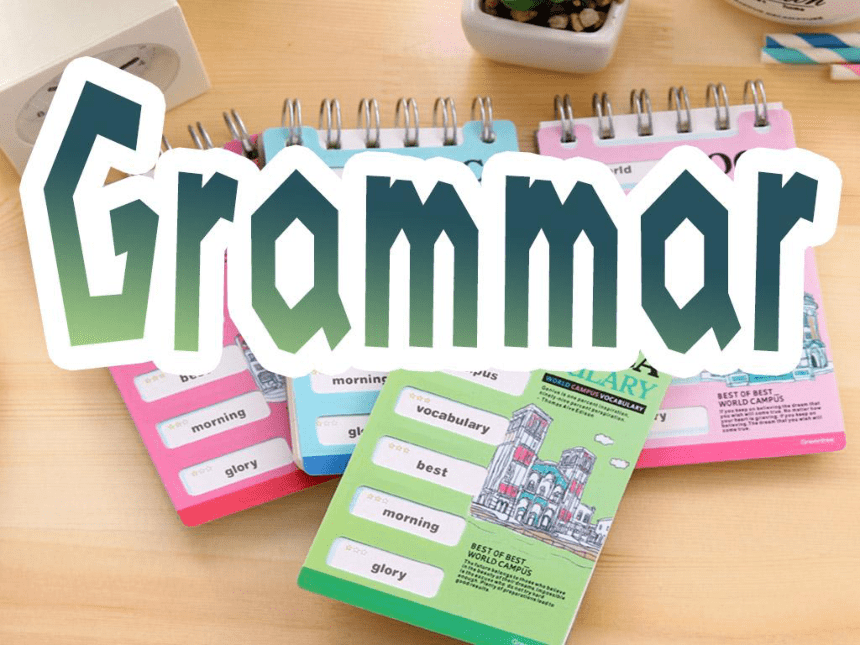
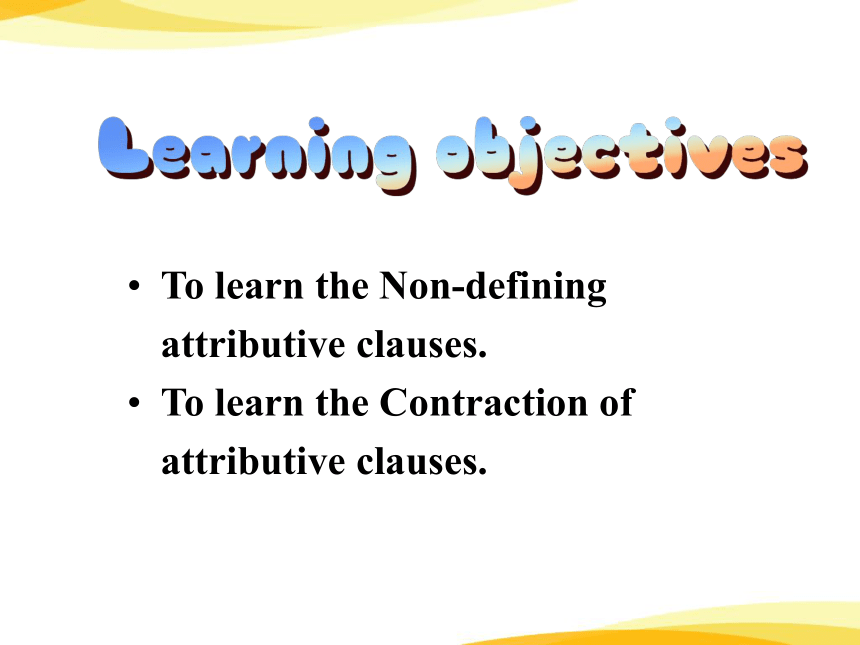
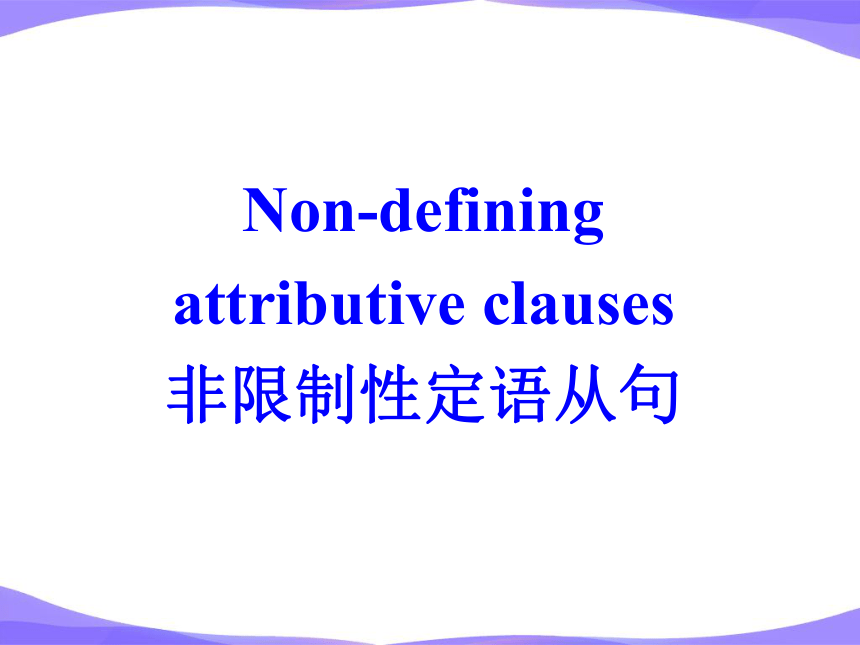
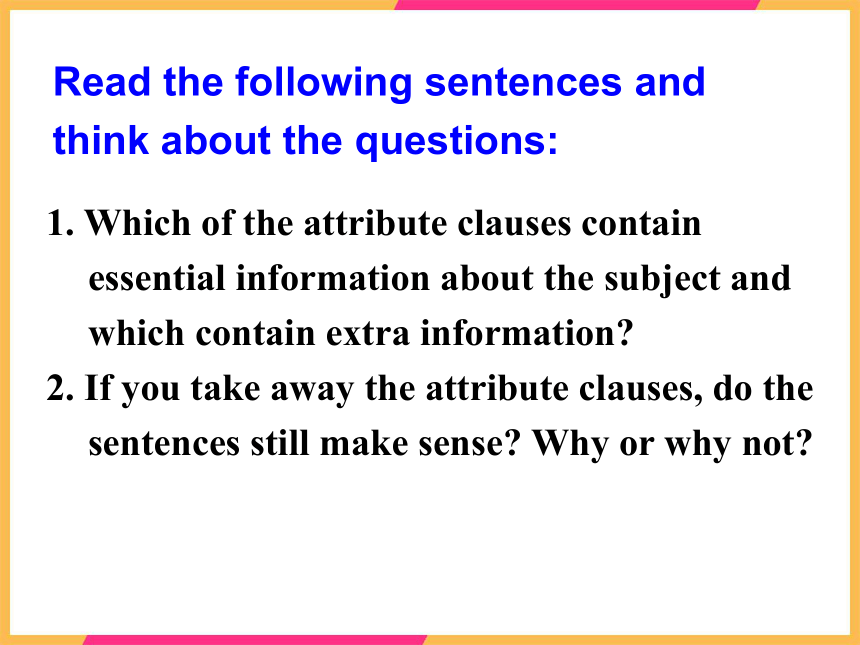
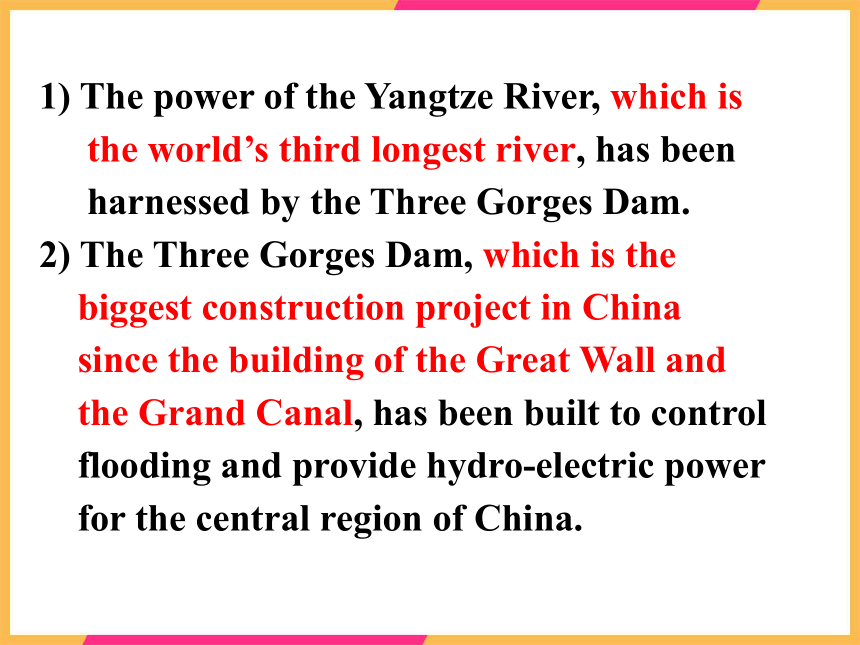
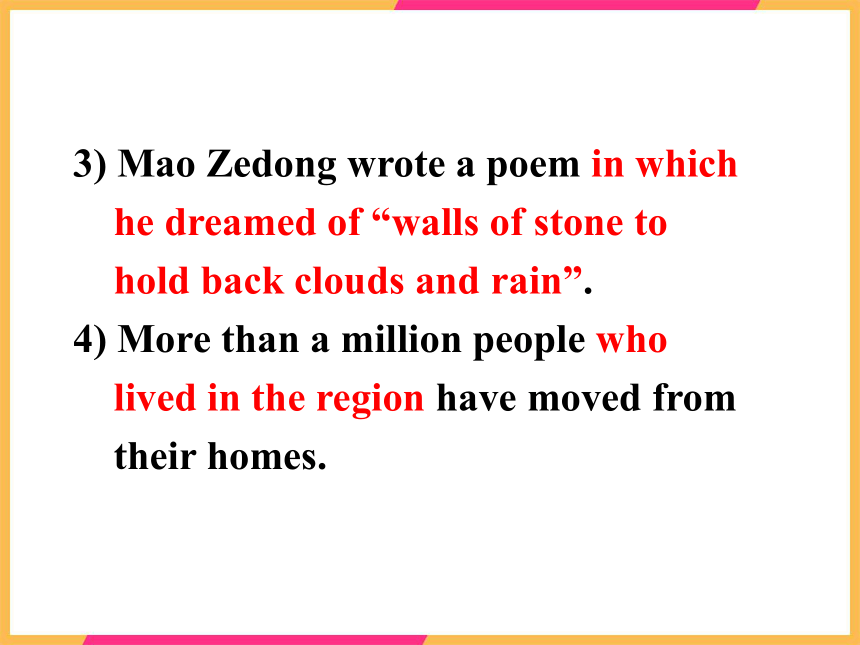

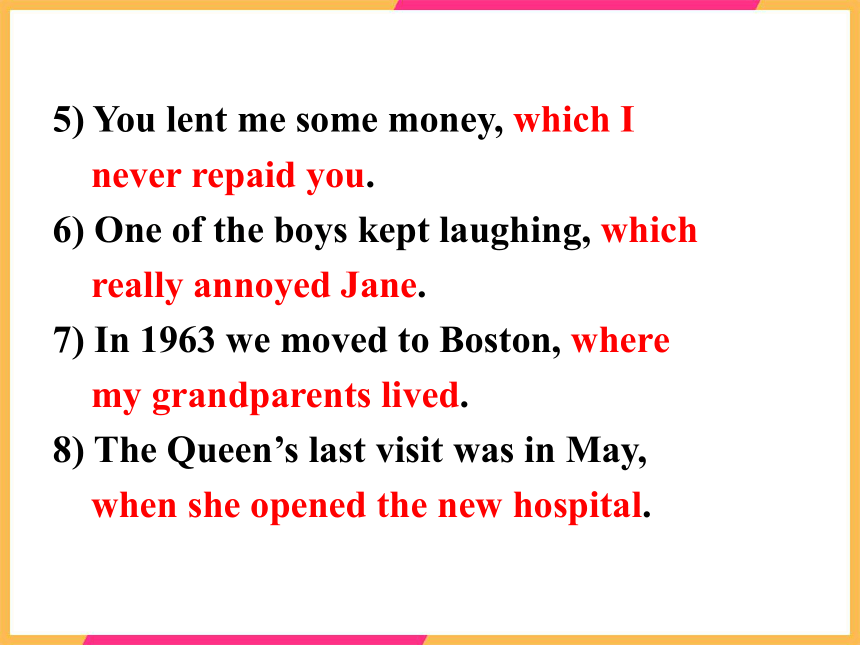
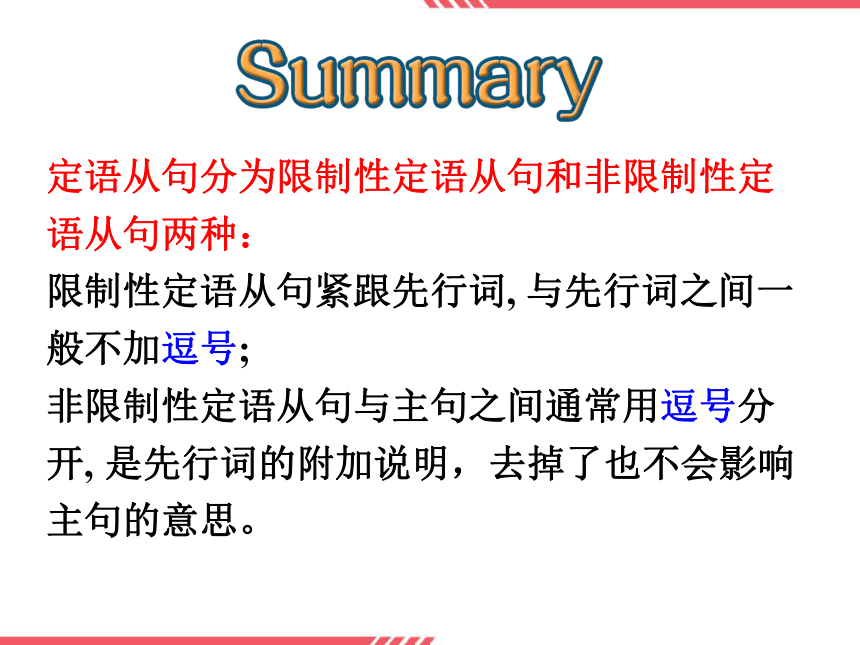
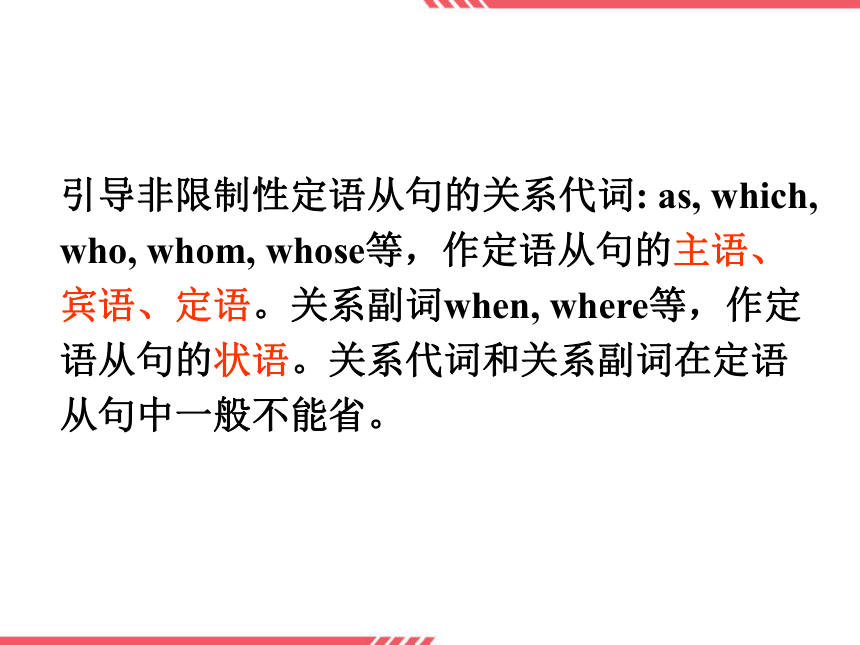
文档简介
(共49张PPT)
Module 6
Module 6
Old and New
To learn the Non-defining attributive clauses.
To learn the Contraction of attributive clauses.
Non-defining attributive clauses
非限制性定语从句
1. Which of the attribute clauses contain essential information about the subject and which contain extra information
2. If you take away the attribute clauses, do the sentences still make sense Why or why not
Read the following sentences and
think about the questions:
1) The power of the Yangtze River, which is
the world’s third longest river, has been
harnessed by the Three Gorges Dam.
2) The Three Gorges Dam, which is the
biggest construction project in China
since the building of the Great Wall and
the Grand Canal, has been built to control
flooding and provide hydro-electric power
for the central region of China.
3) Mao Zedong wrote a poem in which
he dreamed of “walls of stone to
hold back clouds and rain”.
4) More than a million people who
lived in the region have moved from
their homes.
Read more sentences.
1) Mrs. Smith, who has a lot of teaching
experience, will be joining us in the spring.
2) Mary, who / whom we were talking
about earlier, has just walked in.
3) The winner was a Brazilian player,
whose name I have forgotten.
4) The dam, which is the biggest in the
world, is 3,830 metres long.
5) You lent me some money, which I
never repaid you.
6) One of the boys kept laughing, which
really annoyed Jane.
7) In 1963 we moved to Boston, where
my grandparents lived.
8) The Queen’s last visit was in May,
when she opened the new hospital.
定语从句分为限制性定语从句和非限制性定语从句两种:
限制性定语从句紧跟先行词, 与先行词之间一般不加逗号;
非限制性定语从句与主句之间通常用逗号分开, 是先行词的附加说明,去掉了也不会影响主句的意思。
引导非限制性定语从句的关系代词: as, which, who, whom, whose等,作定语从句的主语、宾语、定语。关系副词when, where等,作定语从句的状语。关系代词和关系副词在定语从句中一般不能省。
Differences between the Attributive Clauses and Non-defining Attributive Clauses.
Look at the following sentences and tell the differences between them.
1. His father, who works in Beijing, came back yesterday.
他在北京工作的父亲昨天回来了。
2. Shanghai, which is in East China, is developing quickly.
中国东部的上海正迅速发展着。
Conclusion 1
当先行词是地名、人名、世界上独一无二的事物或家庭唯一成员时,通常只用非限制性定语从句修饰。
3. I have a sister who / that works in a
hospital.
我有一位在医院工作的姐姐。
(不只一位姐姐)
4. I have a sister, who works in a hospital.
我有一位姐姐, 她在医院工作。
(只有一位姐姐)
5. The magazines here which / that have nice pictures in them were written by him. 里面有漂亮图画的那些杂志是他编写的。
6. The magazines here, which have nice pictures in them, were written by him. 所有的杂志都是他编写的, 里面都有漂亮的图画。
Conclusion 2
1. 限制性定语从句与先行词关系密切是先行词不可缺少的部分, 如果去掉它, 主句意思往往不明确。
2. 非限制性定语从句是对先行词的补充或说明, 去掉它也不会影响主句的意思。
7. This is the house (which/ that) we bought last month.
这是我们上个月买的那幢房子。
8. The house, which we bought last month, is very nice.
这房子很漂亮, 是我们上个月买的。
8. He seems not to have grasped what I meant, which greatly upsets me.
他似乎没领会我的意思, 这使我心烦。
Conclusion 3
1. 限制性定语从句可以由关系代词、
关系副词来引导, 关系代词作宾语时可
以省略。
2. 非限制性定语从句既可修饰先行词,
又可修饰整个主句, 不可用that引导
且关系代词不可省略。
1 Sun Yat-sen who became President of the
Republic of China in 1912 died in 1925.
2 The building of the Grand Canal whichh is
the world’s longest canal began in 486 BC.
3 The section of the canal which was built in the seventh century was mainly used for rice transportation.
,
,
,
Read the sentences. Add commas if necessary.
,
,
,
1 The Yangtze River is the third longest river
in the world.
2 The Three Gorges Dam is the biggest
construction project in China.
3 Mao Zedong wrote a poem about a dam
across the Yangtze River.
Add more information to sentences 1-3, using extra inforamtion A-C.
A which is more than 6000 kilometers long
B who is a great leader of China
C which will generate a large amount of energy
Answers:
1 The Yangtze River, which is more than 6000
kilometers long, is the third longest river
in the world.
2 The Three Gorges Dam, which will
generate a large amount of energy,
is the biggest construction project in China.
3 Mao Zedong, who is a great leader of China,
wrote a poem about a dam across the Yangtze
River.
用适当的关系词填空(关系词可省略时填适当的关系词或不填)。
I just read a book called Technostress, 1. ________ was written by Dr. Michelle Weil. Her co-author was Dr. Larry Rosen, 2. _____ is her husband and also a psychologist. According to the authors, everybody feels stressed about technology. Our mobile phones, 3. ________ we buy for emergencies (紧急情况), soon affect our personal life.
which
who
which
Just because they can, people contact us at places 4. ________ we are relaxing. Another problem 5. _________________ we are facing is that we have to learn too much too fast. Technological changes, 6. ________ used to come one at a time, now overwhelm (淹没) us. Dr. Weil suggests that we read her latest book, to 7. ________ we can turn for help when dealing with technostress.
where
that / which / 不填
which
which
1.(2018北京卷)She and her family bicycle
to work, _________ helps them keep fit.
2.(2018天津6月)Kate, _________ sister I
shared a room with when we were at college,
has gone to work in Australia.
3.(2018江苏卷)Self-driving is an area
_______ China and the rest of the world are
on the same starting line.
which
whose
where
4.(2018天津3月)There was a long wait at the reception desk, _______ everyone was checking in.
where
Contraction of attributive clauses
定语从句的缩略形式
a I met a man my grandfather worked with thirty years ago.
b I met a man who my grandfather worked with thirty years ago.
c I wanted to visit the house that my grandparents live in.
d The bus which I took back to my birth place was full of visitors for other parts of China.
Read the following sentences and
answer the questions.
1 Do the first two sentences mean the same thing
2 In the first two sentences, who is the subject or the verb work— the man or the grandfather
3 Can the words that and which be removed from the third and fourth sentences without changing the meaning
Yes, they do.
The grandfather.
Yes, they can.
The valley is now part of the reservoir (which
was) created by the Three Gorges Dam.
The people (who are) living in the village have
moved to other places.
Study these two sentences. Notice the
words in brackets can be delated
without affecting the meaning of the
sentence.
有些定语从句可以缩略为各种短语,动词短语、形容词短语、名词短语、介词短语及动词不定式短语等,且句意不受影响。我们称这一语法现象为定语从句的缩略。
1. 有些定语从句可直接略去作主语的关系代词(who, which, that)和部分谓语(am, is, are, were)等,从而使之缩略为现在分词短语或过去分词短语作后置定语。
e.g. 1) I know the men (who are) sitting in that
car.
2) The boys helped the people (that were) hurt
in the accident.
3) The problem (which is) bothering
everybody is the lack of money.
4) The book (that has been) given to him is an
English novel.
2. 有些定语从句不能按上述方法直接缩略,而
需变动词为分词。这类定语从句一般缩略为
现在分词短语,且在缩略时要考虑现在分词
的时态和词态特征。
e.g. The man who owns that car will
be fined for illegal parking.
→The man owning that car will be fined
for illegal parking.
Bill, who had taken chemistry in high
school, offered to help him.
→Bill, having taken chemistry in high school, offered to help him.
Cross out the relative pronouns where possible.
1. They come from a village that was
submerged in the reservoir.
can’t remove “that”
2. There are many people who prefer to
live in villages.
can’t remove “who”
3. The dam that we saw in the film
wasn’t the Three Gorges Dam.
can remove “that”
4. I’ve got a book that has lots of
information about Zigui County.
can’t remove “that”
5. The students that I met near the
reservoir were from Vietnam.
can remove “that”
6. I received an email from my cousin
who lives near the Three Gorges Dam.
can’t remove “who”
Make each pair of sentences into one sentence.
Example: The mountain is the highest
in the region. We climbed it.
The mountain we climbed is
the highest in the region.
1. The dam provides a large amount of
power. They built it on the river.
The dam (which / that) they built on the river provides a large amount of power.
2. The power station was very modern.
We visited it.
The power station (which / that) we visited was very modern.
3. The village is near the lake. My
grandparents used to live in it.
The village (which / that) my grandparents used to live in is near the lake.
4. The boat went from Wuhan to Zigui.
I took it.
The boat (which / that) I took went from Wuhan to Zigui.
I. 单句改错
1. People often talk about Hangzhou, that is famous for the West Lake.
2. This is the small village where I grew up in.
3. This is the very place where we visited many years ago.
4. There are ten students are playing basketball on the playground.
that→which
去in或者where→which
where→that
students 后加who/that或去掉students后的are
5. English is a subject I am interested.
6. The young man whom you are talking with has gone abroad.
7. Which his parents expect, Tom studies hard and is ready to help others.
subject后加in which或在interested 后加in
with → about
Which→As
8. The day will come which everyone realizes the danger of pollution.
9. That is the most difficult problem which I’ve ever met with.
10. I will never forget the year on which we stayed in America.
which→when
which→that
on→in
II. 用适当的关系词填空。
1. Please show me the book ________ (which /
what) was written by Mo Yan.
2. The Queen’s last visit was in May, ________
(which / when) she opened the new hospital.
3. The hotel, ________ (which / where) we stayed,
was both cheap and comfortable.
4. One of the boys kept laughing, ________
(which / what) made Jane really angry.
5. Mrs. Smith, ________ (who / that) is an
experienced teacher, will be joining us.
which
when
where
which
who
6. Help is needed for families ________ (whose
/ who) homes were destroyed in the
earthquake.
7. The dam, ________ (which / where) is the
biggest in the world, is 3,830 metres long.
8. The people ________ (which / that) called
yesterday want to buy the house.
9. The winner was a Brazilian player, ________
(which / whose) name I have forgotten.
10. In 1963 we moved to Boston, ________
(when / where) my grandparents lived.
whose
which
that
whose
where
Write a diary, which includes the
use of restrictive and non restrictive
attributive clauses.
Module 6
Module 6
Old and New
To learn the Non-defining attributive clauses.
To learn the Contraction of attributive clauses.
Non-defining attributive clauses
非限制性定语从句
1. Which of the attribute clauses contain essential information about the subject and which contain extra information
2. If you take away the attribute clauses, do the sentences still make sense Why or why not
Read the following sentences and
think about the questions:
1) The power of the Yangtze River, which is
the world’s third longest river, has been
harnessed by the Three Gorges Dam.
2) The Three Gorges Dam, which is the
biggest construction project in China
since the building of the Great Wall and
the Grand Canal, has been built to control
flooding and provide hydro-electric power
for the central region of China.
3) Mao Zedong wrote a poem in which
he dreamed of “walls of stone to
hold back clouds and rain”.
4) More than a million people who
lived in the region have moved from
their homes.
Read more sentences.
1) Mrs. Smith, who has a lot of teaching
experience, will be joining us in the spring.
2) Mary, who / whom we were talking
about earlier, has just walked in.
3) The winner was a Brazilian player,
whose name I have forgotten.
4) The dam, which is the biggest in the
world, is 3,830 metres long.
5) You lent me some money, which I
never repaid you.
6) One of the boys kept laughing, which
really annoyed Jane.
7) In 1963 we moved to Boston, where
my grandparents lived.
8) The Queen’s last visit was in May,
when she opened the new hospital.
定语从句分为限制性定语从句和非限制性定语从句两种:
限制性定语从句紧跟先行词, 与先行词之间一般不加逗号;
非限制性定语从句与主句之间通常用逗号分开, 是先行词的附加说明,去掉了也不会影响主句的意思。
引导非限制性定语从句的关系代词: as, which, who, whom, whose等,作定语从句的主语、宾语、定语。关系副词when, where等,作定语从句的状语。关系代词和关系副词在定语从句中一般不能省。
Differences between the Attributive Clauses and Non-defining Attributive Clauses.
Look at the following sentences and tell the differences between them.
1. His father, who works in Beijing, came back yesterday.
他在北京工作的父亲昨天回来了。
2. Shanghai, which is in East China, is developing quickly.
中国东部的上海正迅速发展着。
Conclusion 1
当先行词是地名、人名、世界上独一无二的事物或家庭唯一成员时,通常只用非限制性定语从句修饰。
3. I have a sister who / that works in a
hospital.
我有一位在医院工作的姐姐。
(不只一位姐姐)
4. I have a sister, who works in a hospital.
我有一位姐姐, 她在医院工作。
(只有一位姐姐)
5. The magazines here which / that have nice pictures in them were written by him. 里面有漂亮图画的那些杂志是他编写的。
6. The magazines here, which have nice pictures in them, were written by him. 所有的杂志都是他编写的, 里面都有漂亮的图画。
Conclusion 2
1. 限制性定语从句与先行词关系密切是先行词不可缺少的部分, 如果去掉它, 主句意思往往不明确。
2. 非限制性定语从句是对先行词的补充或说明, 去掉它也不会影响主句的意思。
7. This is the house (which/ that) we bought last month.
这是我们上个月买的那幢房子。
8. The house, which we bought last month, is very nice.
这房子很漂亮, 是我们上个月买的。
8. He seems not to have grasped what I meant, which greatly upsets me.
他似乎没领会我的意思, 这使我心烦。
Conclusion 3
1. 限制性定语从句可以由关系代词、
关系副词来引导, 关系代词作宾语时可
以省略。
2. 非限制性定语从句既可修饰先行词,
又可修饰整个主句, 不可用that引导
且关系代词不可省略。
1 Sun Yat-sen who became President of the
Republic of China in 1912 died in 1925.
2 The building of the Grand Canal whichh is
the world’s longest canal began in 486 BC.
3 The section of the canal which was built in the seventh century was mainly used for rice transportation.
,
,
,
Read the sentences. Add commas if necessary.
,
,
,
1 The Yangtze River is the third longest river
in the world.
2 The Three Gorges Dam is the biggest
construction project in China.
3 Mao Zedong wrote a poem about a dam
across the Yangtze River.
Add more information to sentences 1-3, using extra inforamtion A-C.
A which is more than 6000 kilometers long
B who is a great leader of China
C which will generate a large amount of energy
Answers:
1 The Yangtze River, which is more than 6000
kilometers long, is the third longest river
in the world.
2 The Three Gorges Dam, which will
generate a large amount of energy,
is the biggest construction project in China.
3 Mao Zedong, who is a great leader of China,
wrote a poem about a dam across the Yangtze
River.
用适当的关系词填空(关系词可省略时填适当的关系词或不填)。
I just read a book called Technostress, 1. ________ was written by Dr. Michelle Weil. Her co-author was Dr. Larry Rosen, 2. _____ is her husband and also a psychologist. According to the authors, everybody feels stressed about technology. Our mobile phones, 3. ________ we buy for emergencies (紧急情况), soon affect our personal life.
which
who
which
Just because they can, people contact us at places 4. ________ we are relaxing. Another problem 5. _________________ we are facing is that we have to learn too much too fast. Technological changes, 6. ________ used to come one at a time, now overwhelm (淹没) us. Dr. Weil suggests that we read her latest book, to 7. ________ we can turn for help when dealing with technostress.
where
that / which / 不填
which
which
1.(2018北京卷)She and her family bicycle
to work, _________ helps them keep fit.
2.(2018天津6月)Kate, _________ sister I
shared a room with when we were at college,
has gone to work in Australia.
3.(2018江苏卷)Self-driving is an area
_______ China and the rest of the world are
on the same starting line.
which
whose
where
4.(2018天津3月)There was a long wait at the reception desk, _______ everyone was checking in.
where
Contraction of attributive clauses
定语从句的缩略形式
a I met a man my grandfather worked with thirty years ago.
b I met a man who my grandfather worked with thirty years ago.
c I wanted to visit the house that my grandparents live in.
d The bus which I took back to my birth place was full of visitors for other parts of China.
Read the following sentences and
answer the questions.
1 Do the first two sentences mean the same thing
2 In the first two sentences, who is the subject or the verb work— the man or the grandfather
3 Can the words that and which be removed from the third and fourth sentences without changing the meaning
Yes, they do.
The grandfather.
Yes, they can.
The valley is now part of the reservoir (which
was) created by the Three Gorges Dam.
The people (who are) living in the village have
moved to other places.
Study these two sentences. Notice the
words in brackets can be delated
without affecting the meaning of the
sentence.
有些定语从句可以缩略为各种短语,动词短语、形容词短语、名词短语、介词短语及动词不定式短语等,且句意不受影响。我们称这一语法现象为定语从句的缩略。
1. 有些定语从句可直接略去作主语的关系代词(who, which, that)和部分谓语(am, is, are, were)等,从而使之缩略为现在分词短语或过去分词短语作后置定语。
e.g. 1) I know the men (who are) sitting in that
car.
2) The boys helped the people (that were) hurt
in the accident.
3) The problem (which is) bothering
everybody is the lack of money.
4) The book (that has been) given to him is an
English novel.
2. 有些定语从句不能按上述方法直接缩略,而
需变动词为分词。这类定语从句一般缩略为
现在分词短语,且在缩略时要考虑现在分词
的时态和词态特征。
e.g. The man who owns that car will
be fined for illegal parking.
→The man owning that car will be fined
for illegal parking.
Bill, who had taken chemistry in high
school, offered to help him.
→Bill, having taken chemistry in high school, offered to help him.
Cross out the relative pronouns where possible.
1. They come from a village that was
submerged in the reservoir.
can’t remove “that”
2. There are many people who prefer to
live in villages.
can’t remove “who”
3. The dam that we saw in the film
wasn’t the Three Gorges Dam.
can remove “that”
4. I’ve got a book that has lots of
information about Zigui County.
can’t remove “that”
5. The students that I met near the
reservoir were from Vietnam.
can remove “that”
6. I received an email from my cousin
who lives near the Three Gorges Dam.
can’t remove “who”
Make each pair of sentences into one sentence.
Example: The mountain is the highest
in the region. We climbed it.
The mountain we climbed is
the highest in the region.
1. The dam provides a large amount of
power. They built it on the river.
The dam (which / that) they built on the river provides a large amount of power.
2. The power station was very modern.
We visited it.
The power station (which / that) we visited was very modern.
3. The village is near the lake. My
grandparents used to live in it.
The village (which / that) my grandparents used to live in is near the lake.
4. The boat went from Wuhan to Zigui.
I took it.
The boat (which / that) I took went from Wuhan to Zigui.
I. 单句改错
1. People often talk about Hangzhou, that is famous for the West Lake.
2. This is the small village where I grew up in.
3. This is the very place where we visited many years ago.
4. There are ten students are playing basketball on the playground.
that→which
去in或者where→which
where→that
students 后加who/that或去掉students后的are
5. English is a subject I am interested.
6. The young man whom you are talking with has gone abroad.
7. Which his parents expect, Tom studies hard and is ready to help others.
subject后加in which或在interested 后加in
with → about
Which→As
8. The day will come which everyone realizes the danger of pollution.
9. That is the most difficult problem which I’ve ever met with.
10. I will never forget the year on which we stayed in America.
which→when
which→that
on→in
II. 用适当的关系词填空。
1. Please show me the book ________ (which /
what) was written by Mo Yan.
2. The Queen’s last visit was in May, ________
(which / when) she opened the new hospital.
3. The hotel, ________ (which / where) we stayed,
was both cheap and comfortable.
4. One of the boys kept laughing, ________
(which / what) made Jane really angry.
5. Mrs. Smith, ________ (who / that) is an
experienced teacher, will be joining us.
which
when
where
which
who
6. Help is needed for families ________ (whose
/ who) homes were destroyed in the
earthquake.
7. The dam, ________ (which / where) is the
biggest in the world, is 3,830 metres long.
8. The people ________ (which / that) called
yesterday want to buy the house.
9. The winner was a Brazilian player, ________
(which / whose) name I have forgotten.
10. In 1963 we moved to Boston, ________
(when / where) my grandparents lived.
whose
which
that
whose
where
Write a diary, which includes the
use of restrictive and non restrictive
attributive clauses.
